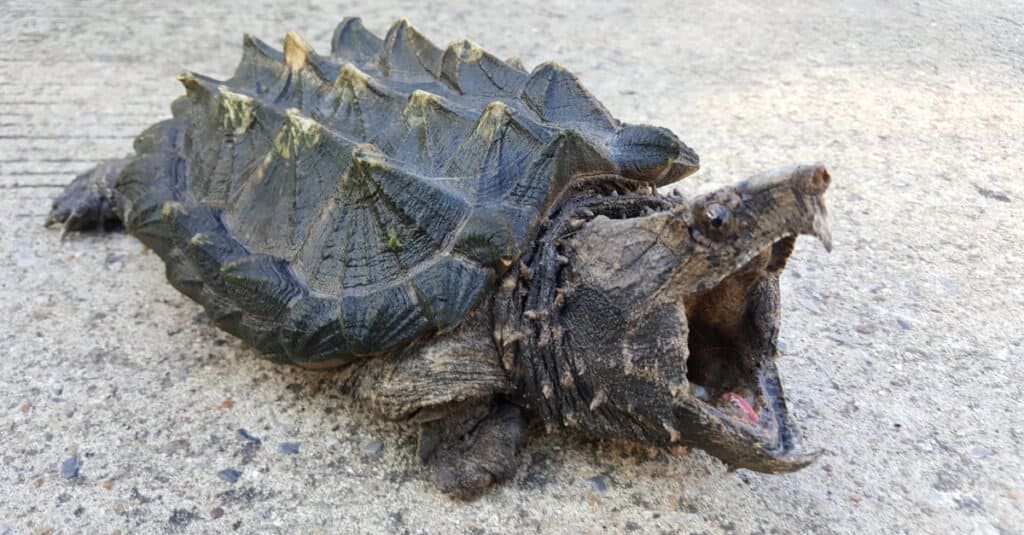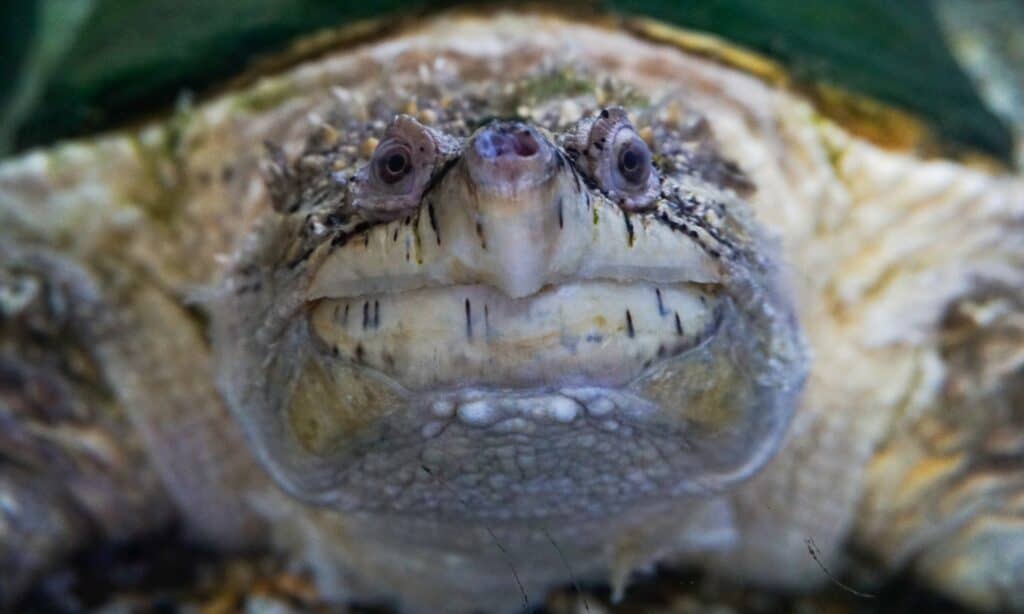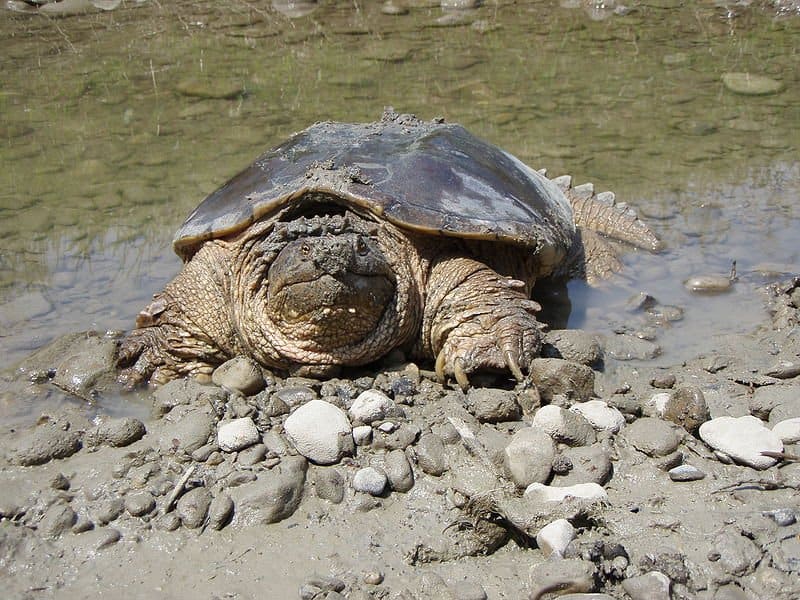The Mississippi River is the second-longest river in North America, behind only the Mackenzie River in Canada. This massive watershed runs for 2,340 miles, beginning in Minnesota in the north, and ending in the Gulf of Mexico in the south.
With such a large river, it’s no wonder that river monsters live in its depths. Here, we’ll learn about the largest turtles ever discovered in the Mississippi River.

The Mississippi River starts out at only three feet deep near its headwaters at Lake Itasca, hardly deep enough for a monster turtle. But, as the river continues its flow southward, its waters deepen to an average depth of 25-30 feet. Farther south, that average goes up to 50-100 feet deep. There is even one section of the Mississippi that reaches 200 feet deep.
With all those miles and all that depth, it’s no wonder that the Mississippi River is home to the largest freshwater turtle in North America. Let’s take a look!
The Largest Turtle in the Mississippi River

The largest turtle ever discovered in the Mississippi River is the
alligator
snapping turtle.
©Sista Vongjintanaruks/Shutterstock.com
The largest turtles ever discovered in the Mississippi River are alligator snapping turtles (Macrochelys temminckii). These turtles can weigh upwards of 100 pounds, and their shells can grow over two feet long. As their name suggests, alligator snapping turtles do one thing very well—snap. They live in both the Mississippi and Illinois Rivers, where they eat a diet made up entirely of fish.
Facts About the Alligator Snapping Turtle

Captive alligator snapping turtles have a lifespan of around 70 years. In the wild, they’re thought to live up to 120 years.
©iStock.com/Jacob Stock
Size and Weight
As the largest turtle ever discovered in the Mississippi River, the alligator snapping turtle is no small fry. Alligator snapping turtles are thought to be the largest freshwater turtles on Earth.
Their only competitors are a few species of freshwater, softshell turtles in Asia, though there is little available data on these turtles. Alligator snapping turtles grow to a maximum shell length of around 30 inches. They have long necks and even longer tails, which can add up to two feet to their overall length.
Male alligator snapping turtles grow to larger proportions than females. The largest specimens weigh well over 100 pounds. However, the heaviest recorded alligator snapping turtles are all zoo specimens. More on the largest wild alligator snapping turtles later.
Appearance

Despite their potential to grow to immense sizes, alligator snapping turtles are sometimes purchased as pets.
©iStock.com/rustyfox
Alligator snapping turtles are the largest turtles ever discovered in the Mississippi River. They’re also among the fiercest-looking turtles in the world. Their shells are thickly armored with three rows of spiked plates that resemble the hide of an alligator. They range in color from nearly black to olive-green, though it can be difficult to determine color through the thick layer of algae.
Alligator snapping turtles are well known for their wicked sharp beaks, which they use to effectively spear fish. Inside their mouth, they have something called a vermiform appendage, which looks like a tiny worm. Outside their mouth, their head is thick and well armored, with long necks. Their legs end in claws that grow longer in males than in females. Finally, at the rear end is the long, tapering tail that resembles nothing so much as a thick snake’s tail.
Location and Habitat
Alligator snapping turtles live only in freshwater. They’re native to the ponds, swamps, lakes, and rivers of the southeastern United States. Like several other species of smaller turtles, alligator snapping turtles call much of the Mississippi River home. They’re highly unlikely to be found in sources of water that do not connect to the Mississippi River watershed. Unfortunately, these turtles have become invasive species in several places, including South Africa.
The largest turtles ever discovered in the Mississippi river prefer stretches of deep, low-visibility water with plenty of mud. Their hunting method requires them to blend into the detritus on the river bottom for many minutes at a time. So, the muddier and more vegetated, the better. Alligator snapping turtles often live in areas with trees overhanging the water as well.
Behavior

Alligator snapping turtles are opportunistic carnivores.
©iStock.com/thomasmales
Alligator snapping turtles are opportunistic carnivores. They’ll eat just about anything they can catch; even carrion. Their diet might include fish, amphibians, aquatic plants, mollusks, smaller turtles, baby alligators, nutrias, muskrats, snakes, invertebrates, crawfish, snails, and insects.
To hunt, these turtles wait on the river bottom with open mouths and vermiform tongues wiggling, mimicking a worm. When something comes in to check out the supposed worm, the turtle snaps its jaws shut.
Alligator snapping turtles don’t start reproducing until they’re around 12 years old. At that point, males and females mate in the springtime. After two months of internal incubation, females lay eggs in clutches of up to 50 eggs. Females build nests on dry land, usually far enough from the water that the eggs are in no danger of drowning.
The Largest Turtles Ever Discovered in the Mississippi River
Alligator snapping turtles weigh well over 100 pounds. On a research trip in 2020, graduate students from the University of Mississippi captured several alligator snapping turtles over 100 pounds. Their largest catch weighed 146.6 pounds and measured 28 inches long in the shell.
They named him Goliath in honor of his size. In addition to Goliath, students also hauled in turtles weighing 138, 126, and 113 pounds. They took carefully recorded data from each turtle before releasing them back into the muddy waters of the Mighty Mississippi.
How Long Do Alligator Snapping Turtles Live?

Alligator snapping turtles are one of the largest freshwater turtle species and are known for their powerful jaws and distinctive appearance.
©Ontley – Public Domain
Alligator snapping turtles are one of the largest freshwater turtle species and are known for their powerful jaws and distinctive appearance. These fascinating reptiles can live a long time, with some individuals living well over 100 years.
In the wild, alligator snapping turtles can live up to 50 years or more. This lifespan is significantly longer than the average lifespan of other freshwater turtle species, which can range from 15 to 30 years. Some captive alligator snapping turtles have been known to live even longer, up to 70 years or more with proper care.
The lifespan of an alligator snapping turtle is largely dependent on several factors, including genetics, diet, and environmental conditions. Turtles that are kept in captive environments and receive proper care, such as a balanced diet and suitable temperature and humidity levels, have a better chance of living longer than those that are kept in less ideal conditions.
It is important to note that the alligator snapping turtle is a species that is currently listed as a threatened species in many areas, with populations declining due to habitat loss, commercial harvest, and other factors. It is important to support conservation efforts to protect these unique and long-lived turtles and to make sure that future generations will have the opportunity to appreciate these amazing reptiles.
Next Up…
Check out some of this awesome content:
- Bobcat vs Lynx: The 4 Key Differences Explained
- 10 Spiders in Georgia
- The 15 Largest Rivers in the World
The photo featured at the top of this post is © Sista Vongjintanaruks/Shutterstock.com
Thank you for reading! Have some feedback for us? Contact the AZ Animals editorial team.







